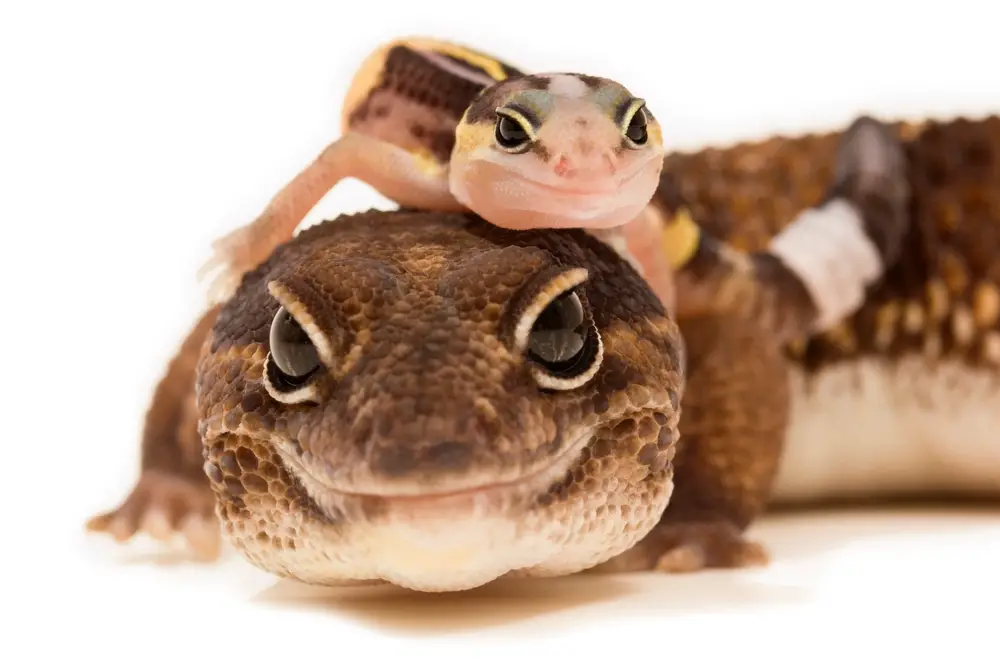African Fat-tailed Gecko care is relatively simple, making them a great species for beginners. Let’s learn more about these gentle lizards…
The African Fat-tailed Gecko, is a shy species that is strictly nocturnal in the wild. Like Leopard Geckos, it belongs to the Eublepharidae family, meaning it has moveable eyelids and is very terrestrial. To care for them, it’s important to cater to their shy nature by providing plenty of hiding places.
African fat-tailed gecko temperature
Temperature for these lizards is almost identical as for Ball Pythons, which is unsurprising given that they both live in West Africa and have similar habits.
They need a temperature gradient to be comfortable, meaning a warm side and a cool side. The warm side should be 89-90F (31-32C), day and night. The cool side should be around 80-82F (26-28C), but can fall as low as 75F (24C) at night.
When it comes to heating, the easiest method by far is using a heat mat. These work great with glass or plastic enclosures, and should be mounted underneath the outside of the enclosure.
As with any heat source, they must be used in combination with a thermostat. For heat mats, I recommend either a “mat stat”, meaning an on/off thermostat, or a pulse-proportional thermostat.
To set it up, you put the heat mat down, then put the thermostat probe on top. You then put the enclosure on top of the probe, so it’s sandwiched between the mat and the enclosure.
Something else you need to do is double check the warm spot temperature on the inside of the enclosure with either an infrared thermometer gun or a digital thermometer.
To choose an appropriately sized heat mat, remember that it should cover about 30% of the bottom of the tank.
To find out what this is, multiply the length x width of your enclosure to get its floorspace in square inches/cm, then put it into the calculator below to find out how big your heat mat should be:
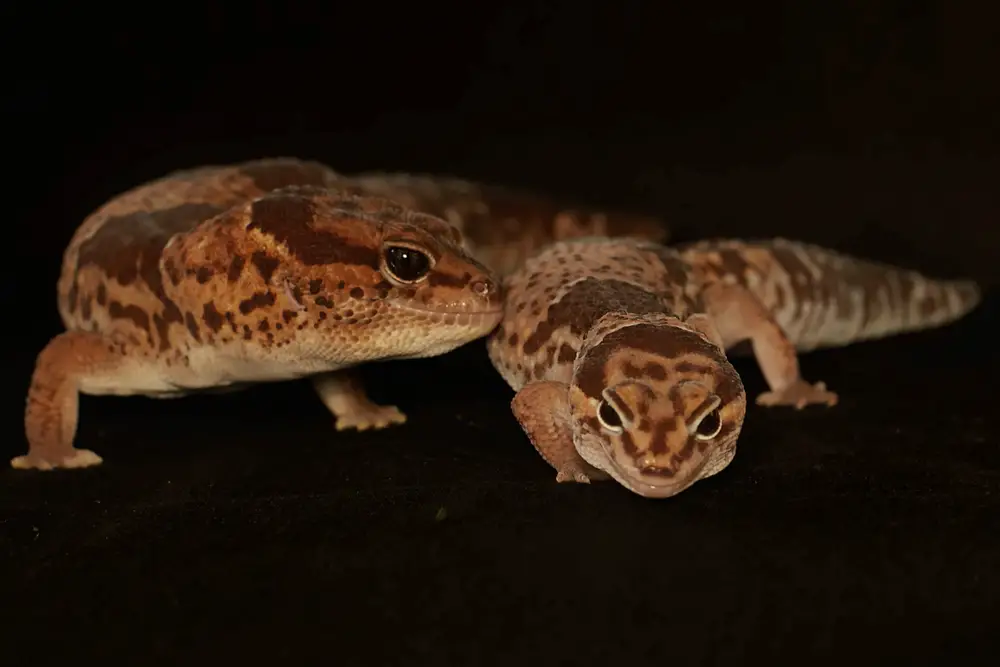
Do fat tailed geckos need a heat lamp?
If you’d rather use a terrarium rather than a tub/tank, your best bet for heating is a heat lamp or ceramic heat emitter.
I would recommend a heat emitter, because it doesn’t give off any light that would disturb your gecko at night. If you do use a heat lamp, make sure that it is at least a red one so that it doesn’t dazzle your pet too much. These are often sold as “night time” bulbs.
For a ceramic heat emitter, you would need to use a pulse-proportional thermostat, whereas for a heat bulb a dimming thermostat is best. Either option must be housed in a protective guard so that there is no possibility of your pet touching it and getting burned (I know it sounds unlikely, but it has happened before!).
As with heat mats, the warm spot generated by one of these heat sources should cover about 30% of the enclosure and needs double-checking regularly with a thermometer gun or digital thermometer.
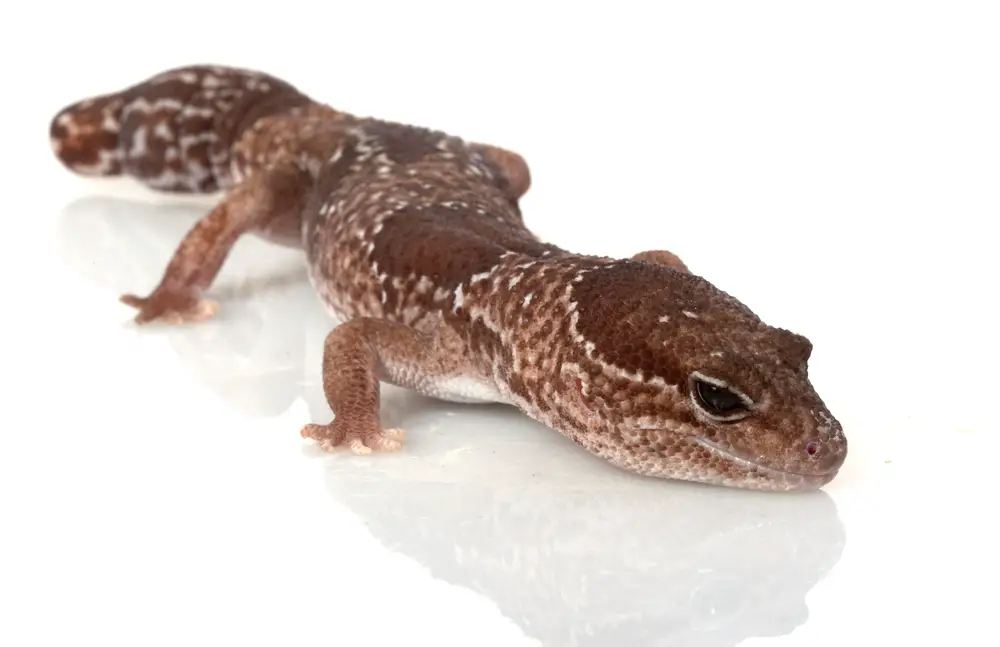
African fat-tailed gecko tank setup
When it comes to choosing a setup for this species, you really have three choices:
- Plastic tubs
- Glass tanks
- Melamine/PVC terrariums
Let’s take a look at the advantages and disadvantages of each, so that you can make your own decision.
- Plastic tubs:
| Advantages | Disadvantages |
| Cheap | Opaque, making viewing difficult |
| Easy to modify with extra ventilation holes, etc. | Ugly to look at |
| Work well with heat mats | Shouldn’t be used with a heat lamp/ceramic heat emitter |
| Hold heat well | |
| Hold humidity well | |
| Come in large variety of sizes, making it easier to scale the enclosure size as your pet grows |
- Glass tanks:
| Advantages | Disadvantages |
| Reasonably cheap | See-through, can make geckos feel less safe |
| See-through, great for viewing | Don’t hold humidity well |
| Work well with heat mats | Don’t hold heat well |
| Work well with heat lamps, ceramic heat emitters |
- Melamine/PVC terrariums:
| Advantages | Disadvantages |
| Look great as naturalistic setups | Expensive |
| Hold heat well | Not recommended for use with heat mats, unless you buy a special mat guard |
| Work well with heat lamps and ceramic heat emitters | Come in less wide array of sizes: it’s harder to scale up the enclosure as your pet grows |
| Have enclosed back and sides, making geckos feel safe | Don’t hold humidity well |
At this point, it’s important to say that my personal choice would be a plastic tub, but you can make any of these setups work. Just make sure that you are always keeping an eye on temperatures and humidity – any setup which maintains these is going to work fine.

African fat-tailed gecko tank size
The ideal enclosure size for adult Fat-tailed Geckos is roughly a 20 gallon long tank. This translates to a tub or terrarium that is around 24inches long, by 18 inches deep and 10-12inches high (roughly). An enclosure that size is great because you can actually house a pair or even a trio in it. This should be 1 male + 1 or 2 females.
Alternatively, most adults also do fine in a ten gallon long tank if kept alone. This would be equal in size to a tub or terrarium that is 18-20 inches long, by 12 inches deep and 10 inches high.
Again these are rough estimates, but in a nutshell:
- a single adult needs an enclosure that is minimum 18L x 12D x 10H inches
- a pair or trio needs minimum 24L x 18D x 10H
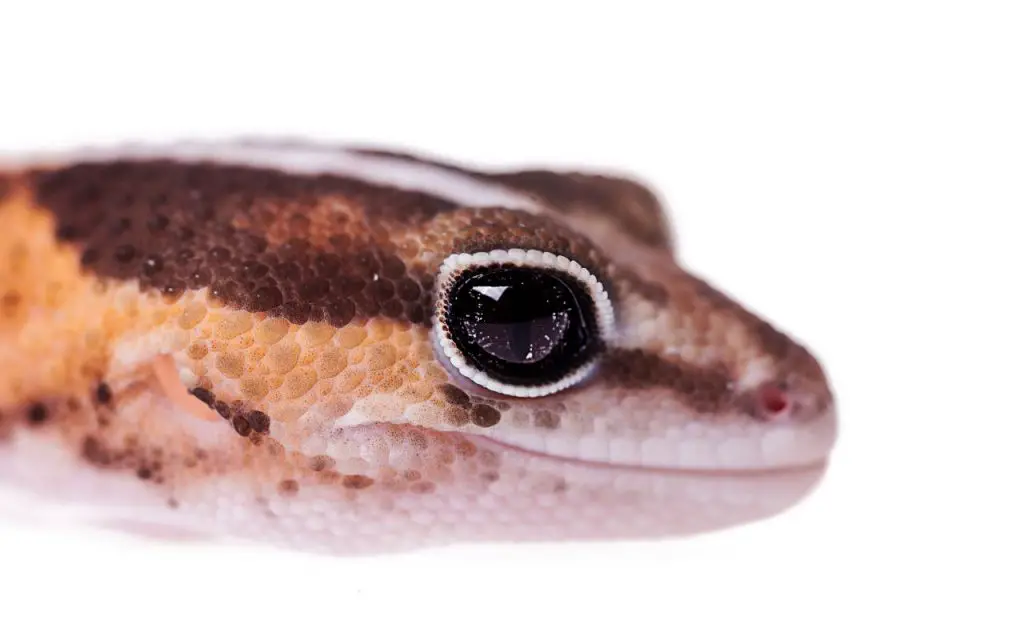
What do fat tailed geckos need in their tank?
Fat-tailed Geckos come from kind of a rough neighborhood in terms of predators. They share their environment with Baboons, Savannah Monitors, and Ball Pythons. They’re also pretty gentle creatures that don’t do too well at sticking up for themselves.
Really, they’re only defence is dropping their tail, so that they can escape while a predator snacks on it.
So, the main thing to remember in their setup is to provide hiding places so they feel safe. They need at least one hiding place in both the warm and cool ends of their enclosure. The hiding places should be just a little larger than they can fit in.
Personally, I like the Exo Terra Reptile Caves, but any heavy resin hiding place will work great.
Asides from hides, your gecko will need a low, heavy water bowl with fresh water at all times. The water depth should be about an inch so that there’s no risk of the lizard getting stuck in the bow and drowning.
For decorations, you can use a variety of fake/real plants, branches and rocks. As Fat-tails are very terrestrial, it’s best to put decorations on the ground, so that it creates variable terrain for them as they explore at night.
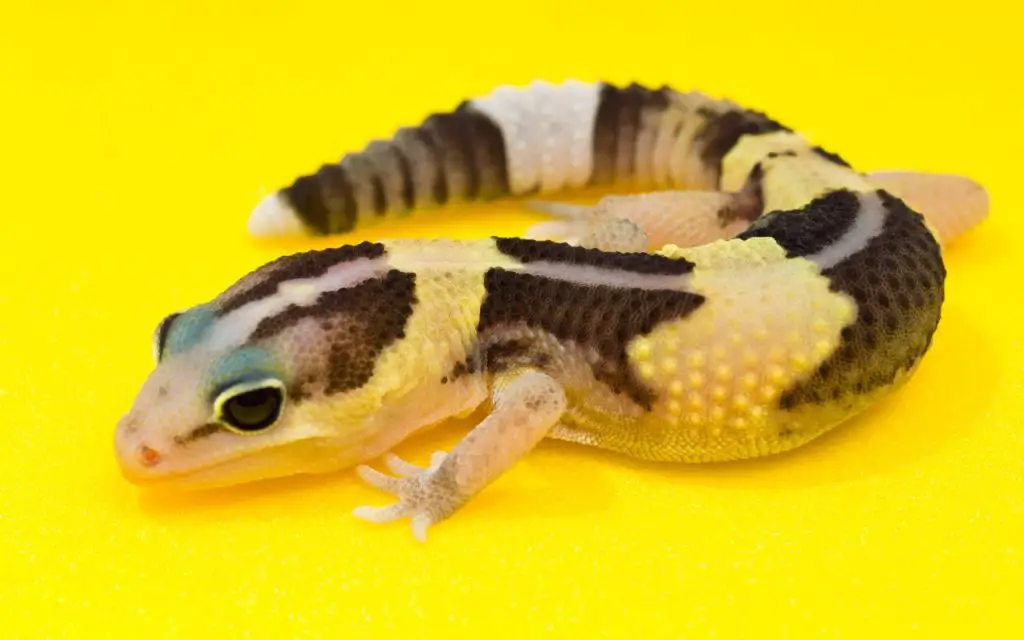
African fat-tailed gecko substrate
For substrate, the most pleasing to the eye is probably coco coir like Eco Earth. Coco coir is great because it helps maintain humidity, and lets your gecko burrow if it wants to.
Alternatively, you can use paper towels or even newspaper. Both options are safe, cheap, and hygienic. African Fat-tailed Geckos aren’t picky about substrate (or much else really) – so long as they always have multiple caves or hides to sleep in.
The only thing I would say is NEVER use sand. Some people still recommend it, but it is a bad idea. There are plenty of documented cases of geckos becoming impacted and dying from ingesting sand.
Diet
Again, no pickiness here! This is probably why I like this species so much… Fat-tails will do great on a diet of mealworms, crickets, Dubia roaches, and hornworms.
To make sure they get all the nutrients they need, you need to sprinkle calcium and vitamin D3 powder on their food before offering it two or three times a week. You should also sprinkle a vitamin and mineral supplement on their food once a week.
Or, to make things simpler, you can just use an all-in-one product like Repashy’s Calcium Plus. You simply dust the crickets or mealworms with it once a week, and your gecko gets everything it needs: much easier!
Baby geckos should be offered 6-10 small mealworms or crickets every day until they are fully grown. Adults can eat full-grown crickets, mealworms or roaches three times a week, and should be offered around 5 or 6 at a time.
Be sure to remove uneaten prey so that it can’t nibble at your gecko. Crickets are pretty easy to spot and catch again. Mealworms like to burrow though, so it’s best to put these in a shallow dish (you can leave this in, it’s crickets and roaches that need removing).
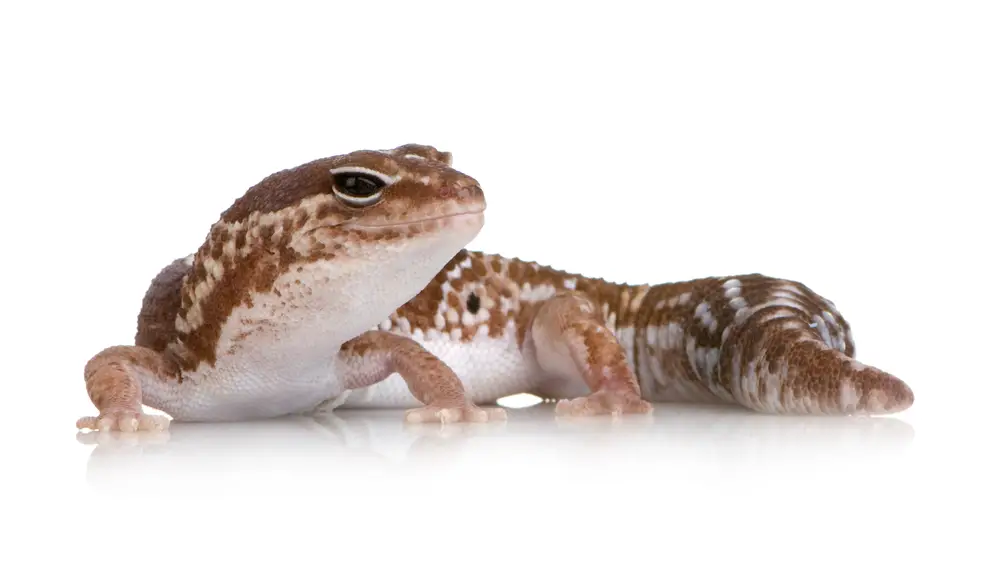
Do African fat tailed geckos need UVB?
Being nocturnal, these geckos don’t need UVB. They have adapted to get all the vitamin D3 they need from food.
However, it’s very hard to replicate their varied wild diet in captivity. So they still need vitamin, calcium, and Vitamin D3 supplementation to prevent illnesses like metabolic bone disease. As I mentioned earlier, it’s a good idea to use an all-in-all supplement to dust their food with.
African fat-tailed gecko humidity
Geckos have delicate skin that requires consistent, correct humidity levels to shed correctly. Aim for around 60% ambient humidity.
Ideally, you should always provide one humid hide, asides from the other hides in the enclosure. Put dampened paper towels or sphagnum moss in this hide, so that your lizard can go in there whenever it feels too dry.
This will help a lot with shedding. One good way of doing it is to use a small plastic container with moss inside and a hole cut in the top. *It’s also cheaper than buying another resin hide.
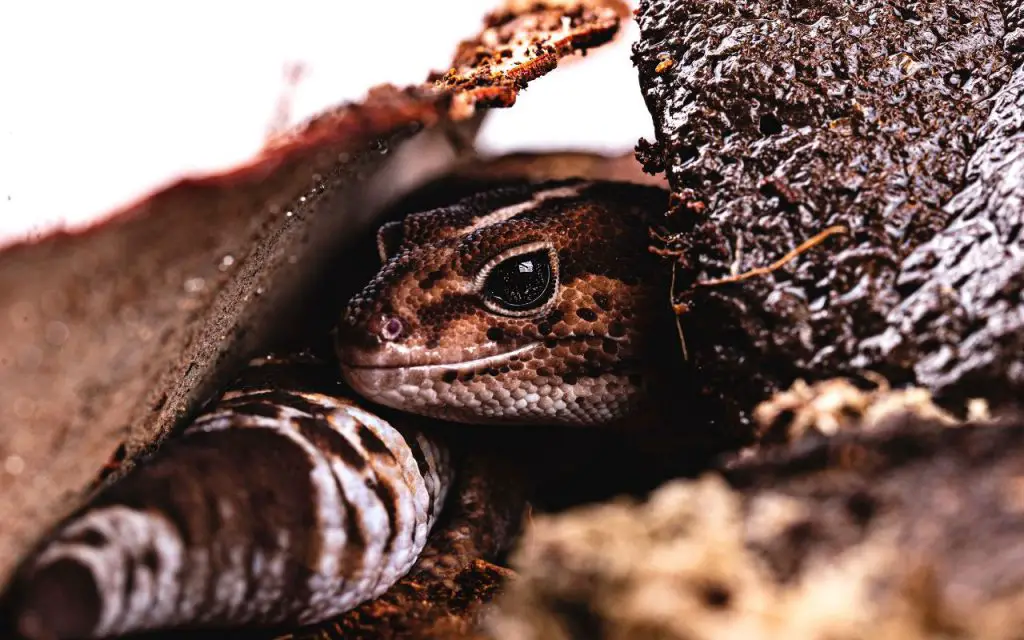
Do fat-tailed geckos need misting?
If you have put a humidity gauge in your geckos enclosure and you see that it regularly drops below 60%, then try misting.
You can mist with a plant fogger once or twice a week. Don’t get the enclosure soaking wet, though. You just want to add enough moisture to the substrate to help keep ambient humidity levels up.
Handling
African Fat-tailed Geckos are extremely gentle, shy creatures. They can take a while to get used to you. In fact, I had one years ago that refused to eat if you watched it. I didn’t see it eat for over a year! It was healthy, fat, and in good health. It was just very, very shy.
That said, they can become tame pets with regular, gentle handling. Just make sure that you scoop them up gently and allow them to walk over your hands.
Never grab them by the tail, as they can drop them and won’t hesitate to do so if they feel at all threatened. Overall, it’s fair to say they’re a little more slow-moving than Leopard Geckos, but perhaps more shy.
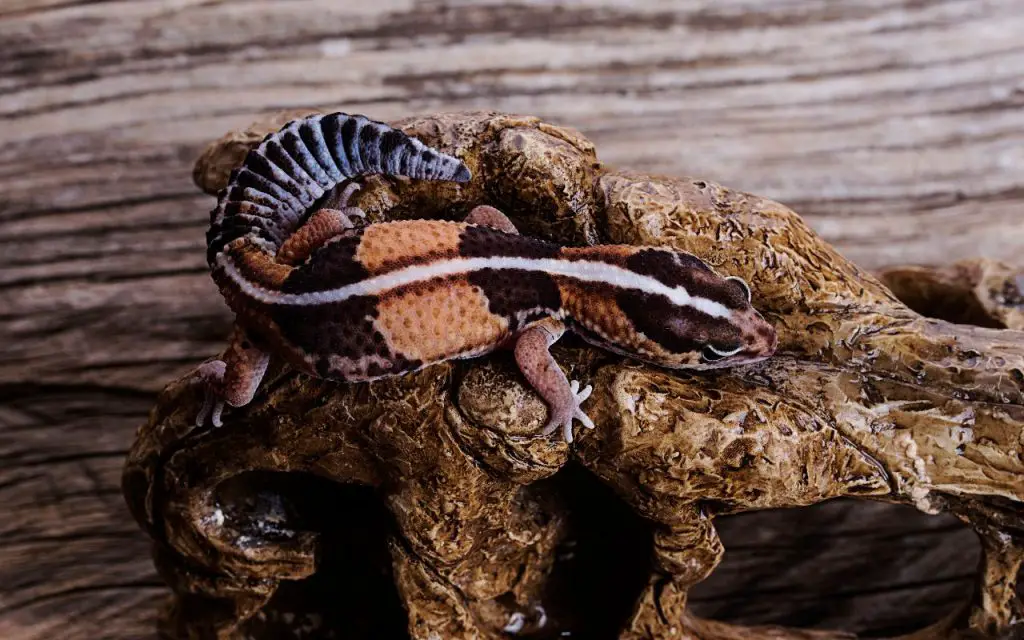
How long do African Fat-tailed geckos live?
So, at this point I have to let you know that these lizards will only live past a few months if you get the following things right:
- diet
- vitamin/calcium supplementation
- heat
- hiding places
- humidity
That is your main check-list for a long-lived Fat-tail! Get these factors right and your pet could live anywhere from 12 to 20 years. Some have even lived to the age of 25.
African fat tailed gecko for sale
Fat-tailed Geckos are pretty widely available in the US and Canada. Go on morphmarket.com at any given time and you’ll see about 6 or 7 pages of ads with them for sale.
Prices range from about $100 for a normal one, to as much as $600 for some of the more unusual morphs (color variations).
In the UK and Europe, they are much less common. You can find them, but nowhere near as easily as you can find Leopard, Gargoyle, or Crested Geckos. Again, your best bet is to look on Morphmarket, where prices start at around £85/€95.
African Fat-tailed Gecko Care summary
| Common Name: | African fat-tailed gecko |
| Scientific Name: | Hemitheconyx caudicinctus |
| Distribution: | West Africa |
| Lifespan: | 12-25 years |
| Size: | 8-10 inches/20-26cm |
| Temperature: | 89-90F (31-32C) on the warm end and 80-82F (26-28C) on the cool end |
| Humidity: | 60% ambient, provide humid hide |
| Favourite food: | Crickets, mealworms, roaches |
| Enclosure size: | Minimum 10 gallon tank or tub that measures 18L x 12D x 10H inches |
| Activity rhythm: | Strictly nocturnal |
| Lighting needs: | UV light not necessary, but ambient lighting beneficial |
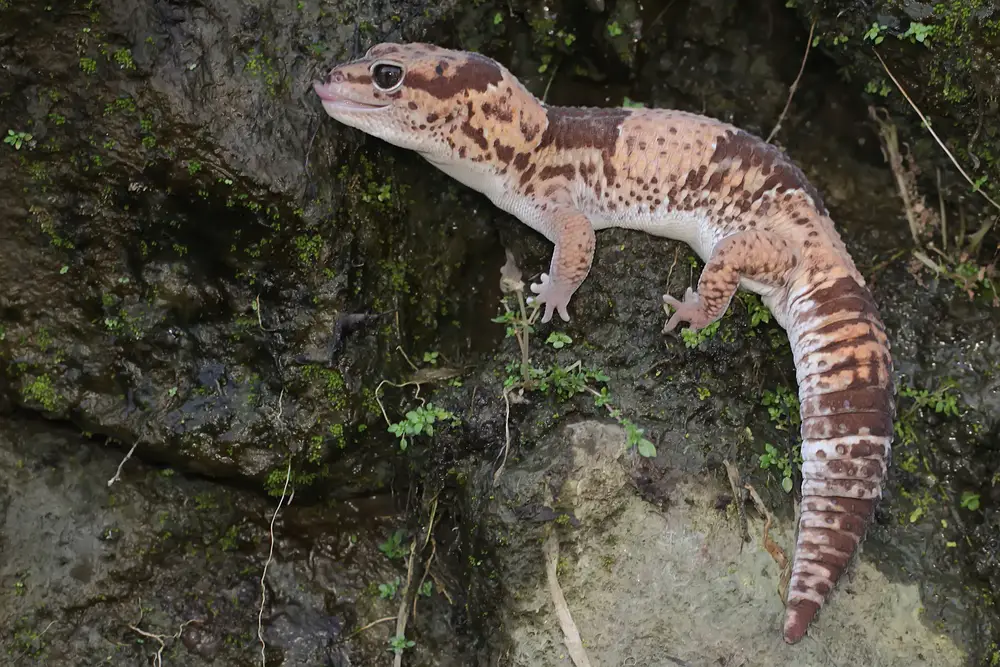
FAQ relating to African Fat-tailed Gecko Care Sheet
How often should I feed my African fat-tailed gecko?
Baby Fat-tailed Geckos need feeding small prey every day. Adults must be fed full grown prey about three times a week. Food should be smaller than the lizards head. Any crickets/roaches that remain uneaten after a few hours should be removed, but mealworms can stay in the enclosure in a shallow dish.
What is the best bedding for African fat tail gecko?
Fat-tailed Geckos do great on paper towels or even newspaper, so long as you change them regularly. Or, if you want a more natural look, coco coir (Eco Earth) is a great choice. They can burrow in this and it holds humidity well.
Do fat-tailed geckos need Moss?
Moss is a good idea but not 100% necessary as part of their substrate. It is useful to fill a humid hide, though. You will find that providing a humid hide helps your gecko shed its skin well and stay healthy.
Can you overfeed a gecko?
It is quite hard to overfeed a gecko. In my experience, Fat-tails stop eating when they’ve had enough and obesity is not a common problem. The main problem with feeding them too much is that uneaten crickets can annoy your lizard or even nibble at it if you leave them in the enclosure.

